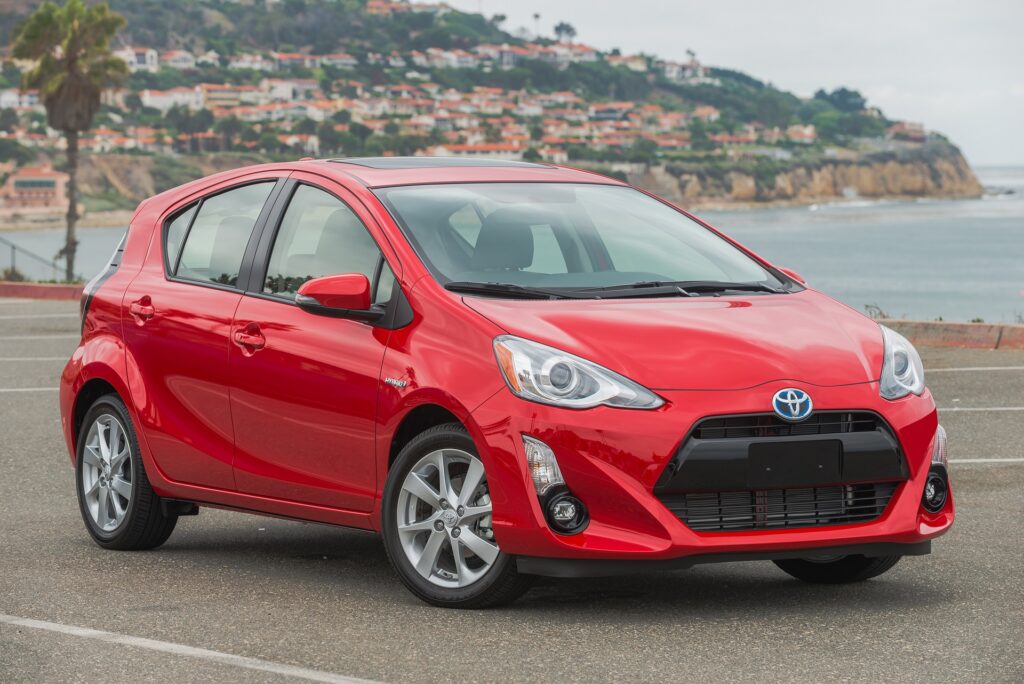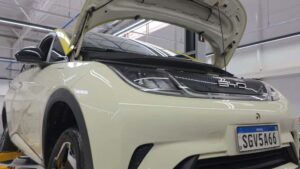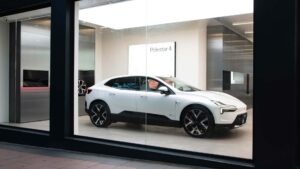
The 2018 Toyota Prius C is showing its age; it lacks refinement and is no longer top of the pack on fuel economy, while cheap gas makes the $20K price a heavy lift.
The 2018 Toyota Prius C is the least expensive hybrid from the company that’s made more hybrids than any other. Now in its seventh and perhaps last year, the 2018 Prius C is a compact hatchback that’s the smallest of the four-car Prius lineup. For 2018, it gets some minor styling tweaks after a more comprehensive front and rear restyle last year. The trim levels are easy to understand: they’re called One, Two, Three, and Four.
We rate the 2018 Toyota Prius C at 5.2 points out of a possible 10, which is slightly above average for new cars, buoyed by its fuel economy score. (Read more about how we rate cars.)
A small 1.5-liter inline-4 is paired to Toyota’s hybrid system and a scaled-down battery pack small enough to fit under the rear seat. Inside, the Prius C is more conventional than the Space Age design of other Prius models, but it’s also clearly an economy car, with basic plastics and not a lot of noise suppression.
On the road, the Prius C is slow and when pressed, remarkably noisy. It gets more fun if you push it hard, but the noise and lack of power mean you’ll pay the price for any attempts at street-racer antics. Toyota added modern electronic safety features to the littlest Prius last year, but it still lacks a number of features now offered in newer subcompacts.
With its closest competitor, the unsuccessful Honda Insight, now gone from the market, the Prius C competes with a range of less expensive but newer and nicer subcompact sedans and hatchbacks. It may also vie with the latest generation of the larger Prius Liftback, which was entirely redesigned in 2016.
With gasoline cheap these days, its mix of high fuel-economy ratings and lower price may not be as appealing as they were when it launched. And the subpar performance and refinement are hard to escape, especially against its much-improved big brother, the Prius Liftback.
The 2018 Toyota Prius C has more conventional design than other Prius models, but its interior still says econobox.
The 2018 Toyota Prius C doesn’t “look like a hybrid,” and its smooth rounded nose and conventional side profile and tail are especially welcome against the odd and overwrought lines of the larger Prius Liftback. It doesn’t have a two-part rear window or the horizontal tailgate of the main Prius. Its conventional hatchback is flanked by two vertical taillights and capped by a long roof spoiler, for aerodynamic reasons. Many people might never know it’s a hybrid at all.
We give the Prius C 4 out of 10 points for design and styling, docking it a point for some cheap painted-metal areas inside. (Read more about how we rate cars.) Upgrades this year include new 15-inch eight-spoke machined alloy wheels with dark grey accents, and black accents on the roof rails, side rockers, and wheel-arch moldings.
The interior of the Prius C still features a multi-information display in the center of the dash just below the windshield, but items like the switches and console are conventional—and may well be familiar to Yaris owners. The oddball Prius drive selector stalk is gone, replaced by a conventional chrome shift lever on the tunnel. Three years ago, Toyota upgraded some interior plastics and materials, but while that helps, the little Prius suffers in comparison to the modern, intuitive dashboard and controls of the Hyundai Ioniq Hybrid. Doors close with a hollow thud, and the overall impression remains more econobox than finely engineered hybrid.
The 2018 Toyota Prius C is best nipping around town, where its low power and noisy acceleration are less obvious.
The powertrain of the 2018 Toyota Prius C hasn’t changed in seven years: it’s a 73-horsepower 1.5-liter inline-4 paired to 60-hp electric motor, giving a total combined output of 99 hp. It’s not a fast car, and you may have to work at it to keep up with traffic consistently. That in turn will produce a lot of noise from the small engine as it puts out its full, meager power. We rate the Prius C at 3 out of 10 for its performance, docking it one point each for slow acceleration and lack of refinement in the process. (Read more about how we rate cars.)
Like the Ioniq Hybrid, the Prius C sites its battery pack (a 0.9-kwh unit) under the rear seat next to the gas tank, giving it a full-depth cargo bay. If you want to use all of that battery, a dash button lets drivers choose EV mode, but it lasts only half a mile or so at low speeds. An Eco mode cuts the climate-control outputs for better fuel economy; we tested it for half a mile and then gave up. Frankly, even driven energetically, the Prius C should return real-world fuel economy somewhere in the 40s, at least in temperate climes.
Against the previous generation of Prius Liftbacks, the Prius C felt nimble and communicate on the road. But the latest version, launched in 2016, is notably better on that score, and the Prius C is now only about average for subcompacts. It’s best in urban traffic, zipping around town and jousting for stop-light positions and tight parking spots. It’s not even close to a sporty hatch, but it’s not bad to toss around. On the highway, though, the noise and low power make it less fun.
The 2018 Toyota Prius C offers a competitive feature set against other subcompacts, but it’s no longer ahead of the pack.
The 2018 Toyota Prius C comes in a logical progression of trim levels, helpfully named One, Two, Three, and Four. All versions, even the base Prius C One, include standard LED headlights and taillights; automatic climate control; power windows, locks, and mirrors; keyless entry; a 6.1-inch touchscreen with a USB port; and a rearview camera. That was a pretty advanced package in 2012, but now it’s only average. We give the Prius C 6 out of a possible 10 points for its features. (Read more about how we rate cars.)
Moving up the range, the Prius C Two adds an engine immobilizer, cruise control, and split-folding rear seats for more cargo flexibility. The Three layers on satellite and HD radio and a built-in navigation system. At the top of the range, the Prius C Four provides niceties like heated seats and outside mirrors, LED fog lamps, and optional alloy wheels of a different design. For the Three, only a single option is available, a moonroof.
Interesting in an aging but fuel-efficient small hatchback, at a price starting around $20,000, may be low in these days of low fuel prices. Sales of the Prius C have fallen every year since 2013.



